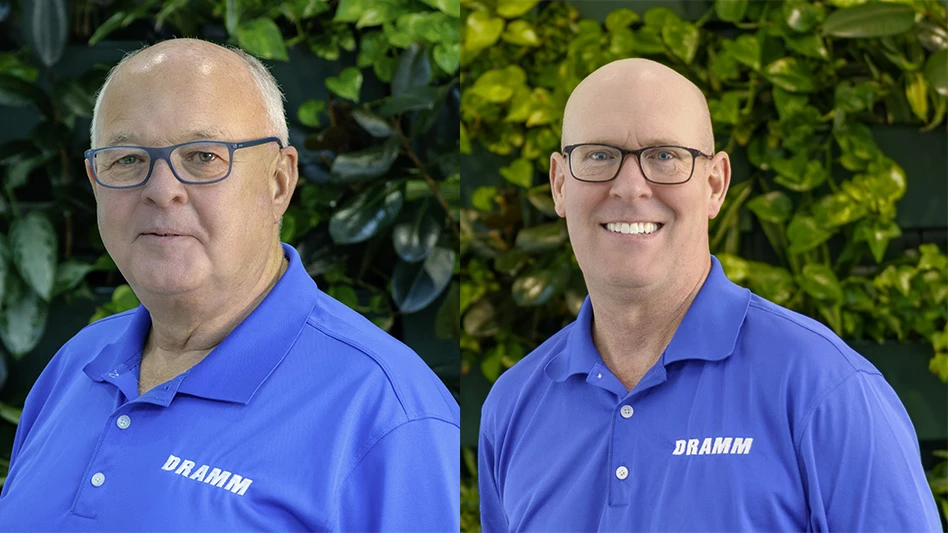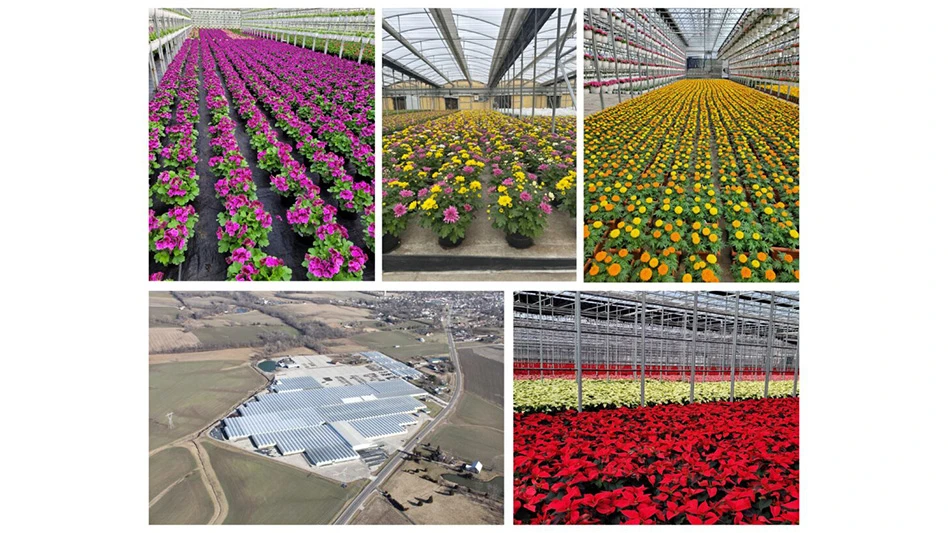
As winter arrives with fury across much of the U.S, we easily forget dealing with the heat and lack of rain during the dog days of summer. Each year, daily daytime maximum temperatures and nighttime minimum temperatures increase for part or much of the summer, leading growers to adopt alternative production practices. As a result, shade cover production area is expanding throughout the Southern United States to combat the heat, reduce crop stress, minimize crop losses, and expediate time to market. Other growers are addressing the heat by overhead irrigating in short intervals throughout the day (i.e., syringing) to lower crop canopy temperatures and minimize wilt.
While focusing on protecting the seemingly more exposed plant canopies may seem intuitive, the roots — which are adapted to a relatively cool and stable below-ground climate — are far more heat-sensitive. In the summer, roots of container-grown plants endure much higher temperatures than the above-ground portions. Conventional black or dark-colored plastic containers exposed to solar radiation heat up rapidly, resulting in media temperatures that can be 20 to 30°F higher than the ambient air temperature. Maximum daily media temperatures in fully exposed containers commonly exceed 115°F in the Southern US, occasionally exceeding 130°F during the hottest days of summer. Even in Northeast Ohio, daytime media temperatures have been shown to remain above 95°F for approximately 70 hours over the summer production season.
For hardy trees and shrubs to tropical plants, media temperatures greater than 100°F for five hours or 113°F for 30 minutes can severely injure roots, leading to negative effects on crop growth, quality, and survival. Just as important, your fertility program is “dialed-in” based on media temperature, with controlled release fertilizer rate and longevity calibrated on a media temperature of 70°F or 80°F.
In the below table, we have listed considerations when monitoring and evaluating media temperature. The “rules of thumb” provide a quick reference when looking at media temperature data at your nursery. These critical temperature values can vary from the provided “rules of thumb” when assessing your controlled release fertilizer products and injury to the individual genera, species, and even cultivars you grow.
The bad news is you cannot control the weather; the good news is you can influence media temperature through certain routine production practices. Irrigation schedule, irrigation water temperature, container wall exposure to direct and reflected sunlight as a result of container spacing, pruning, and the container type and color all have an impact on media temperature.
Irrigation schedule and water source

Each irrigation event cools the growing media mainly by replacing the hot water held in your media with cooler water and, to a lesser degree, by post irrigation evaporation from the plant canopy, media surface, and surrounding ground. Research conducted in Raleigh at North Carolina State University showed that PM cyclic irrigation, applied at 12 p.m., 3 p.m. and 6 p.m., reduced maximum media temperatures from 116°F to 104°F when compared to a single predawn irrigation event. In addition, media temperature remained considerably cooler from 12 p.m. to 3 a.m. the next morning, an equivalent of 15 hours of cooler media each summer day. In our recent study, we found shrub dogwood root and shoot growth increased by 50% and 30% when maximum media temperature was lowered by only 5°F through afternoon cyclic irrigation compared to a single morning irrigation of equal total daily run time.
In addition to irrigation schedule, the temperature of water applied during an irrigation event determines its effective cooling capacity on the growing media. Ground water, especially from deeper wells, can better cool the media than above-ground holding tanks or shallow reservoirs. Deep (≥ 25 feet) reservoirs with a large freshwater retention capacity can provide cooler water than shallow reservoirs for much of the season if the intake is set near the bottom.
Container spacing, color and type
Jeremy Pickens’ program at Auburn University (Mobile, Alabama, campus) recently showed that holly grown in can-tight (i.e., non-spaced) black containers had less root injury, resulting in a 20% increase in growth compared to those grown in containers spaced 5 inches apart. In addition, the researchers showed that holly grown in white pots in the interior of the production bed had less root injury and more shoot growth than those produced in black containers, regardless of container spacing. Similarly, we found that compared to conventional black plastic containers, white containers lessened heat stress on roots, providing equal (Ohio) or substantially better (Tennessee) root and shoot growth across many economically important species, including panicle hydrangea, smooth hydrangea, bigleaf hydrangea, shrub rose, dogwood, and arborvitae. The lower media temperatures in white containers also increased nutrient retention in the incorporated controlled release fertilizer by 7 to 12% in Wooster, Ohio, and 14 to 35% in McMinnville, Tennessee. The slower release of nutrients coupled with healthier roots and larger shoots reduced phosphorus leaching up to 40%.

Containers that promote evaporative cooling or wicking of water from the container walls, including pulp, coir, fabric, or other porous walled containers, will also reduce growing media temperature by approximately 3°F to 6°F but will require more water to produce an equal sized plant. Pot-in-pot, where a containerized plant is placed in an above- or below-ground “socket” pot will also alleviate high media temperatures. It is important that the production pot be properly nested in the socket pot to minimize solar radiation exposure to the production container wall.
Tinkering with temperature
You, as a grower, can measure temperature of the media in different production settings at your operation. Robust and easy-to-use standalone sensors or those added to Meter, Onset, Spectrum or other platforms will allow you to see how your production practices and infrastructure affect media temperature. While we do not endorse specific products, we recommend finding one that’s easy to place in the media, reads media temperature continually, and allows easy access to the temperature data. If not currently using dataloggers or environmental monitoring equipment, we have used the reusable, individual $75 Bluetooth Pendant water temperature dataloggers with replaceable batteries. These half-dollar-sized, wireless loggers can be placed in the center of a marked pot and set to record temperature every 10 minutes. Media temperature data can be downloaded using a free mobile app via Bluetooth or after the logger is retrieved from the pot at time of shipping. Data plotted in the mobile app or via desktop software will allow you to see temperature extremes in the media (Fig. 1), calculate average media temperature, and identify which production practices are having the largest impact on your growing media temperature.
When altering production practices to lower media temperatures, keep in mind that cooler springtime media temperatures may cause a lag in nutrient release from your controlled release fertilizer, resulting in slower “green up” or delaying the first flush of growth. Heavy feeders grown in pots with cooler-than-normal media temperatures should be monitored closely, keeping in mind the crop’s final quality and size, and time to market. You may find a delay in nutrient release does not affect time of sale and may cut down on the number of required prunings or plant growth regulator applications. If you notice continued nutrient deficiency symptoms into the season, share your media temperature data with your controlled release fertilizer technical representative to identify a product that aligns with your cooler media temperatures.
Monitoring growing media temperature in a few containers is a low-investment, easy-to-adopt practice that can help you keep a pulse on root heat stress, identify which media-cooling production practices are working best in your operation, and make data-supported decisions on a fertility program tailored specifically to your growing conditions. In the meantime, research will continue to examine the effect of media temperatures’ impact on crop health and fertility with the goal to predict past and present media temperatures using only atmospheric weather conditions.
Drs. James S. Owen Jr. (jim.owen@usda.gov) and Jake Shreckhise (jacob.shreckhise@usda.gov) are Research Horticulturists for the United States Department of Agriculture Agricultural Research Services in Wooster, Ohio, and McMinnville, Tennessee.
Explore the January 2025 Issue
Check out more from this issue and find your next story to read.
Latest from Nursery Management
- Terra Nova Nurseries introduces rust-free and disease-resistant heucherella
- John T. Nickel, founder of Greenleaf Nursery Co., passes away at 89
- Three tours offered at 2025 Farwest Show
- Garden Media Group announces sixth annual Women in Horticulture Week
- Star Roses and Plants announces National Knock Out Rose Day
- The Growth Industry Episode 4: How federal budget cuts are affecting horticulture nonprofits
- Pennsylvania Horticultural Society shares top gardening trends from 2025 Philadelphia Flower Show
- California Spring Trials 2026 dates announced





